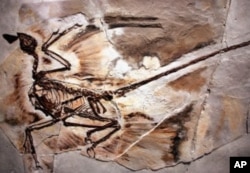Paleontologists have unearthed an ancient tropical forest in northern China that is so well preserved in volcanic ash that they say it is like seeing a snapshot of a moment in time nearly 300 million years ago.
The University of Pennsylvania-led team of U.S. and Chinese researchers says ash from a large volcanic eruption that occurred approximately 298 million years ago covered the tropical foliage so quickly - in a matter of only a few days - that many of the plants and trees fell in the exact spot where they grew. Some smaller-sized trees actually were preserved in their entirety, with leaves, branches, trunk and cones intact.
The researchers say the high-quality and abundance of specimens allowed them to create the first reconstruction of a peat-depositing tropical forest in Asia. The extensive findings represent a new baseline on which any new, less complete finds will be evaluated.
The scientists say the forest remains were studied at three large sites covering a total of 1,000 square meters. It is the first peat-depositing tropical forest of this time period ever discovered. Over millions of years, such peat beds would have transformed into coal deposits that are mined today.
The paleontologists compare their ancient tropical forest to the eerily well-preserved ruins of ancient Roman city of Pompeii, which was buried in volcanic ash in the year 79. Now an important archaeological site, Pompeii offers researchers deep insight into Roman culture more than 1,900 years ago.
The scientists say, just like Pompeii, the tropical forest in northern China captures only an instant in history, but also provides valuable context for interpreting the time before and the time after the critical moment when it was frozen by a volcanic eruption that both destroyed and saved it.
The study co-authors say the tropical forest near what is now Wuda, China flourished during the early Permian geologic period when the Earth’s landmasses were in the process of converging to form a single supercontinent known as Pangaea.
A report on the new findings is published in the journal, Proceedings of the National Academy of Sciences.









